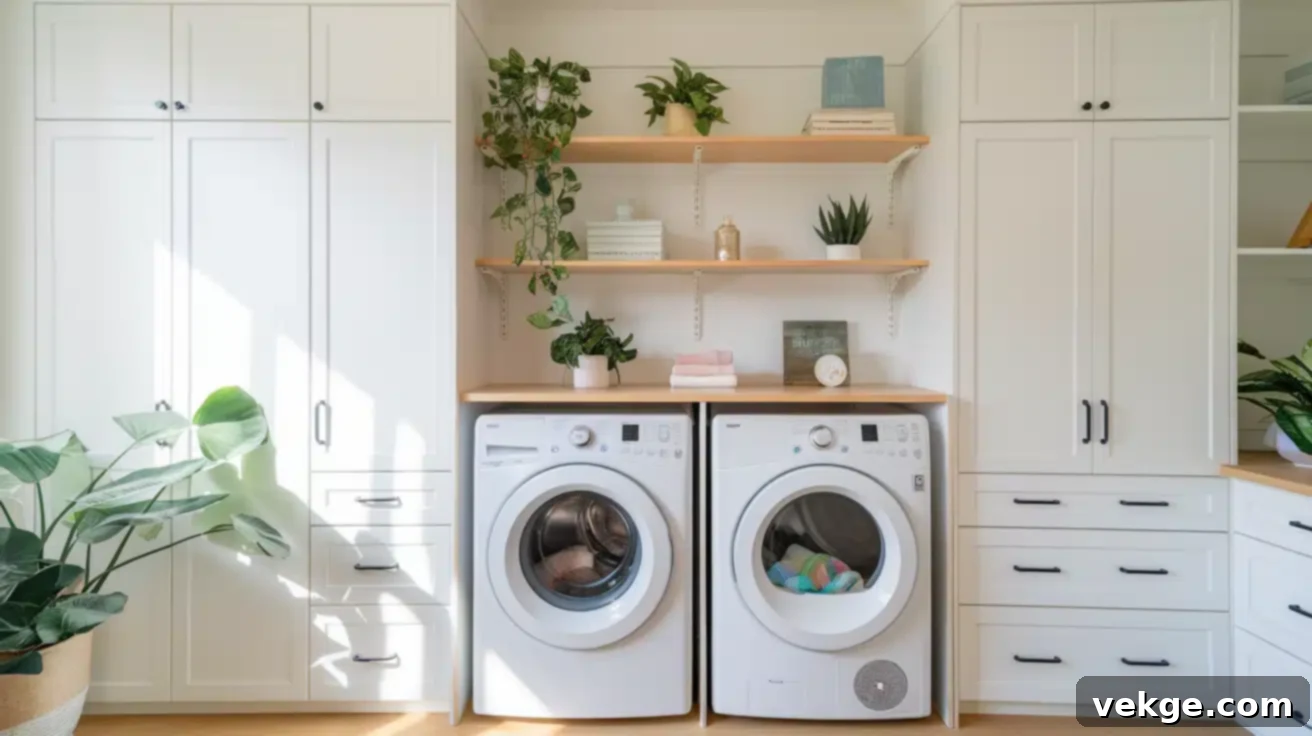Unlock Efficiency and Style: Your Comprehensive Guide to Designing the Perfect Dream Laundry Room
In today’s fast-paced world, every corner of our homes is being reimagined for both utility and aesthetics. The humble laundry room, once a mere functional space, has evolved significantly. It’s no longer just about washing clothes; it’s an opportunity to create a serene, efficient, and well-organized area that streamlines household chores and reduces stress.
With the right blend of thoughtful setup, smart storage solutions, and a touch of design flair, your laundry room can transform into one of the most productive and enjoyable areas in your home. This comprehensive guide will walk you through how to design a laundry room that perfectly aligns with your available space, personal needs, and daily routine, ensuring it becomes a true asset to your household.
Key Features for a Truly Dream Laundry Room
A meticulously designed laundry room can elevate a routine chore into a remarkably smooth and efficient process. It’s more than just a place to clean clothes; it’s a dynamic, functional area that should reflect your home’s unique style while meeting your specific demands. Every detail, from the layout to the finishes, contributes to creating a laundry room that genuinely works for you.
Smart Storage Solutions
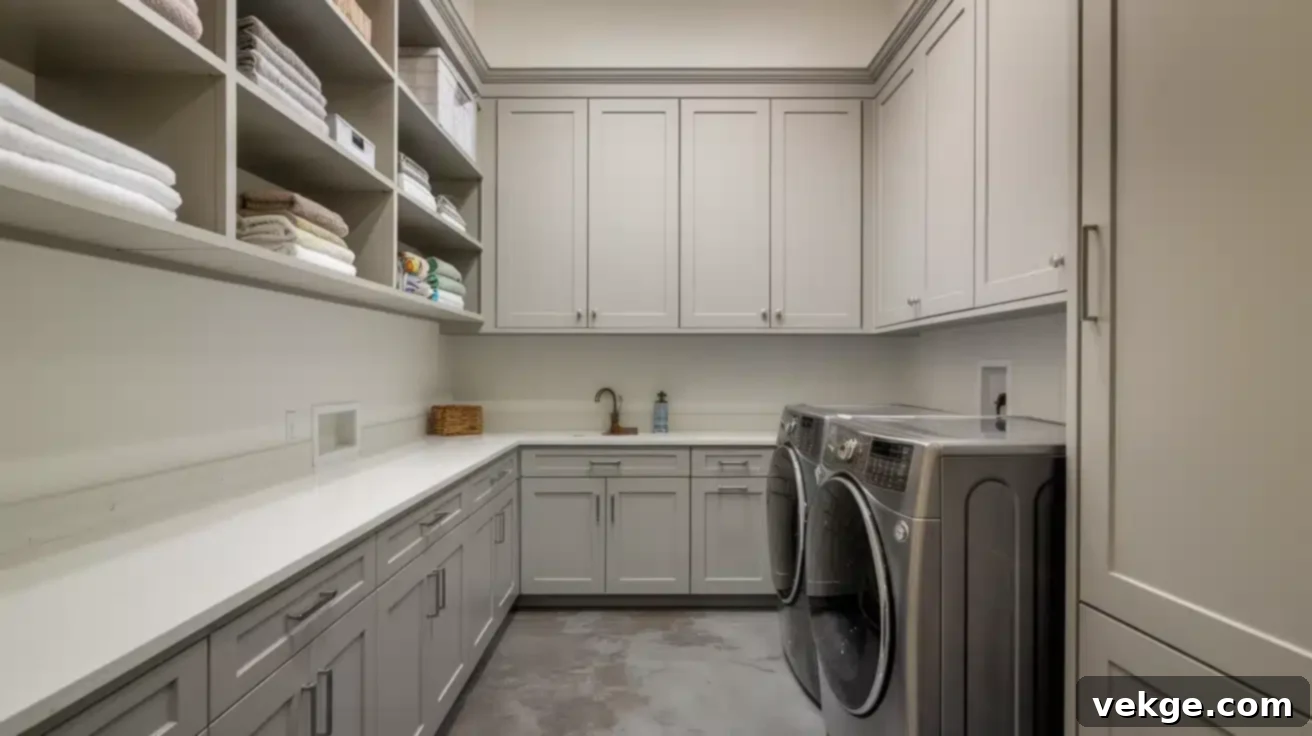
The foundation of an exceptional laundry space lies in smart design and practical storage. Custom cabinetry is a game-changer, transforming utilitarian areas into highly organized havens. Opt for floor-to-ceiling storage to maximize every available square inch, allowing you to neatly tuck away detergents, cleaning supplies, and linen.
A generously sized countertop, ideally around 36 inches in depth, provides the perfect folding and sorting station. Materials like durable quartz are excellent choices, as they can withstand daily use, resist stains, and are easy to clean. Incorporate pull-out shelves or drawers within cabinets for easy access to often-used items, and consider dedicated compartments for laundry baskets or hampers to keep them out of sight.
Innovative Room Features
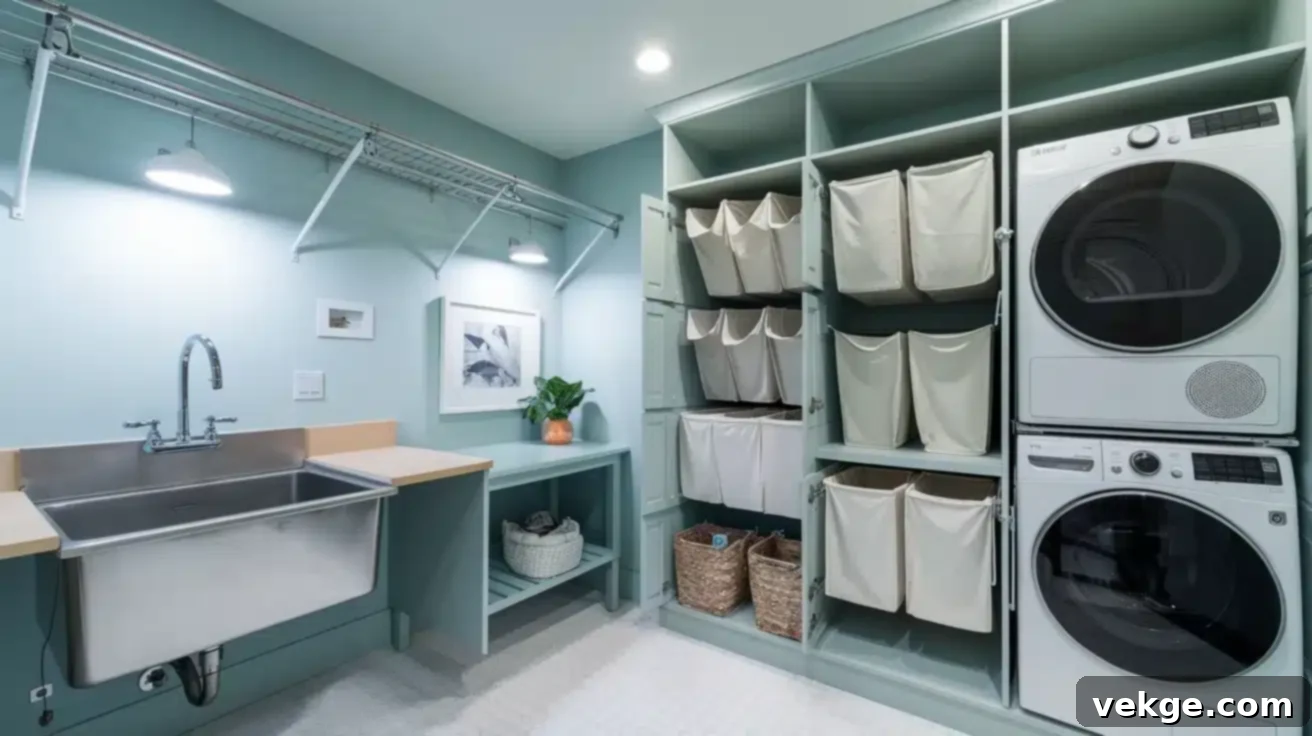
Modern laundry rooms incorporate innovative features that significantly enhance both function and ease of use. A deep utility sink equipped with a flexible spray nozzle is invaluable for pretreating tough stains, hand-washing delicates, or even rinsing muddy shoes. Wall-mounted drying racks or retractable clotheslines offer flexible storage for air-drying garments without taking up permanent floor space.
Strategic lighting is crucial; combine ambient ceiling lights with task-specific illumination under cabinets or above work surfaces to ensure every corner is well-lit for stain inspection and detailed tasks. Pull-out hampers with multiple compartments simplify sorting whites, colors, and delicates, while integrated smart technology allows for seamless control of modern appliances, helping you manage laundry cycles remotely and efficiently.
Designing for Comfort and Efficiency

The ultimate laundry room strikes a perfect balance between practicality and comfort. Prioritize moisture-resistant materials for all surfaces, including flooring, walls, and cabinetry, to prevent mildew and ensure longevity. Easy-to-clean surfaces, such as large format tiles or sealed concrete, will make maintenance a breeze. Ergonomic design is also vital: think about counter heights that reduce back strain during folding, and placement of appliances that minimize bending and reaching.
Thoughtful touches like soft-close drawers and cabinet doors reduce noise, hidden electrical outlets maintain a clean aesthetic, and clever organizational systems transform laundry from a dreaded chore into a smooth, almost enjoyable process. Your ideal laundry room should feel organized, highly functional, and genuinely pleasant to spend time in.
Popular Styles to Inspire Your Laundry Room Design
Choosing a distinct style for your laundry room can help unify all your design elements and create a cohesive, inviting atmosphere. Here are a few popular looks that homeowners adore, each offering its own unique feel and functional benefits.
Modern and Minimal
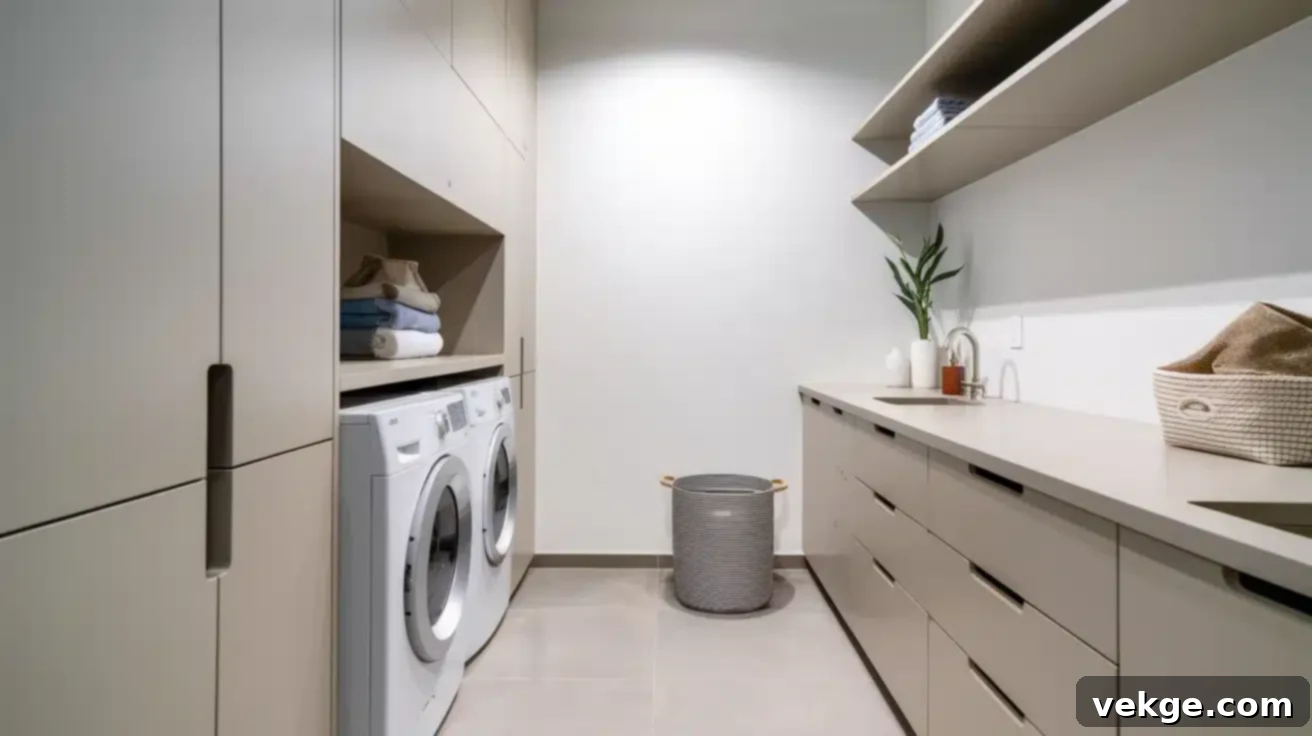
The modern and minimal style is defined by simplicity, clean lines, and impeccable order. It features flat-front cabinetry, sleek hardware, and a palette of soft, neutral colors such as whites, grays, and natural wood tones. In this design, everything has a designated place, and clutter is meticulously kept out of sight, promoting a calm and organized environment. This aesthetic makes the laundry room not only highly practical but also visually pleasing and stress-free to use. It’s an excellent choice for those who appreciate neat, easy-to-maintain spaces that exude a sense of tranquility and contemporary elegance.
Farmhouse and Rustic

Farmhouse and rustic laundry rooms infuse warmth and an inviting charm into the space, creating a cozy, lived-in feel. Key elements often include open shelving crafted from natural wood, shiplap walls that add texture and character, and vintage-style sinks or fixtures that evoke a sense of history. Natural textures, distressed finishes, and warm, earthy tones are central to this style, combining practical functionality with a strong sense of personality. This approach makes the laundry room feel like a welcoming and integral part of the home, offering a comforting retreat for daily chores.
Vintage Charm
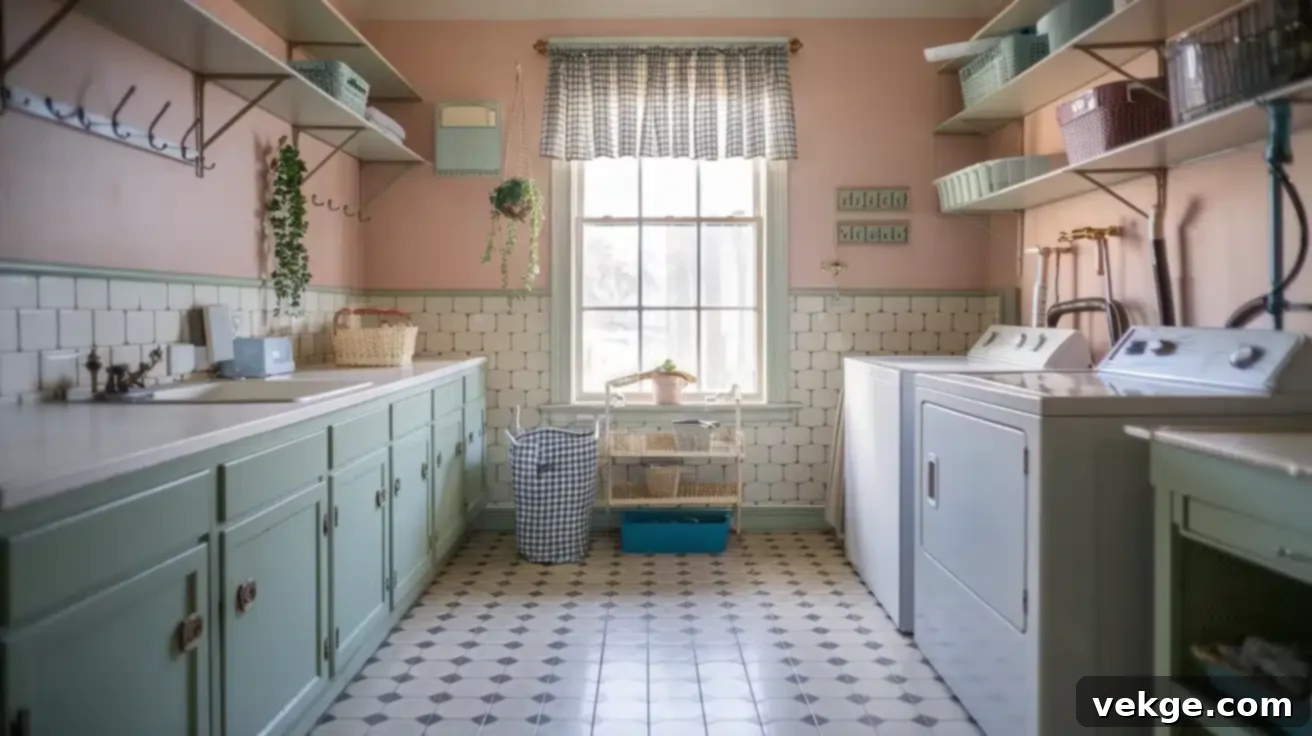
Embrace the timeless appeal of the past with a vintage charm laundry room, incorporating classic design elements for a gentle, nostalgic ambiance. This style often features patterned tiles, soft muted colors like sage green or dusty blue, and fixtures that harken back to bygone eras. Open shelving adorned with curated display items and aged or antique-style hardware further enhances the character and charm. By blending old-world details with everyday functionality, this design creates a space that feels both familiar and refreshingly unique, transforming laundry chores into a more delightful experience.
Coastal and Bright
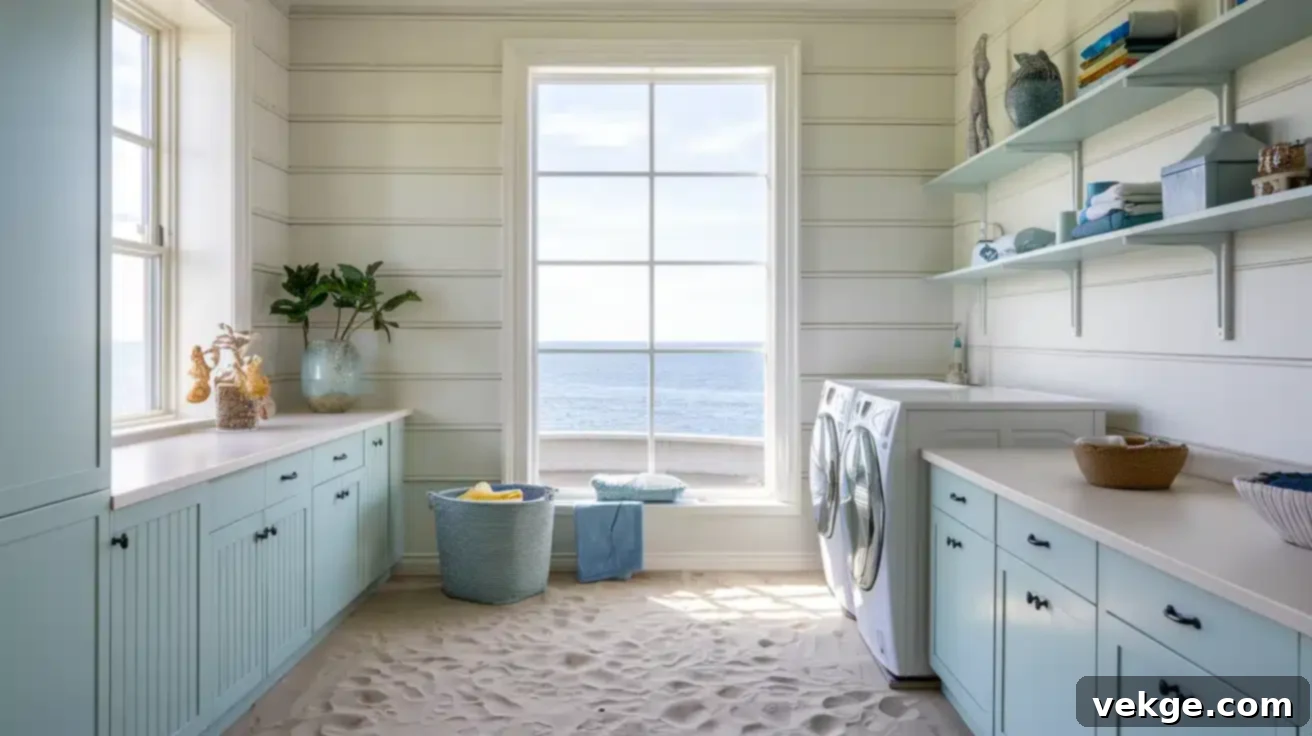
The coastal and bright style aims to create a fresh, airy, and open laundry space that feels inherently clean and calm. Light colors are paramount, with crisp whites, sandy beiges, and soft blues evoking a breezy, seaside atmosphere. Open shelving, decluttered surfaces, and an emphasis on natural light contribute to making the space feel larger, more inviting, and wonderfully serene. This style is an excellent choice if you desire a relaxed, low-maintenance look that still appears well put together and offers a refreshing escape from daily demands.
Industrial Chic

The industrial chic style boldly blends robust materials like metal and wood to forge a practical space with a distinctive, slightly rugged appeal. This look frequently incorporates exposed piping, wire baskets for storage, and a palette of darker, sophisticated tones such as charcoal gray, deep navy, or matte black. Strong, resilient finishes, including matte black hardware, concrete countertops, or industrial-style lighting fixtures, add both durability and undeniable style. It’s an ideal fit for those who favor a sturdy, no-fuss design that maintains a highly polished and intentional aesthetic.
Step-by-Step Guide to Creating Your Dream Laundry Room
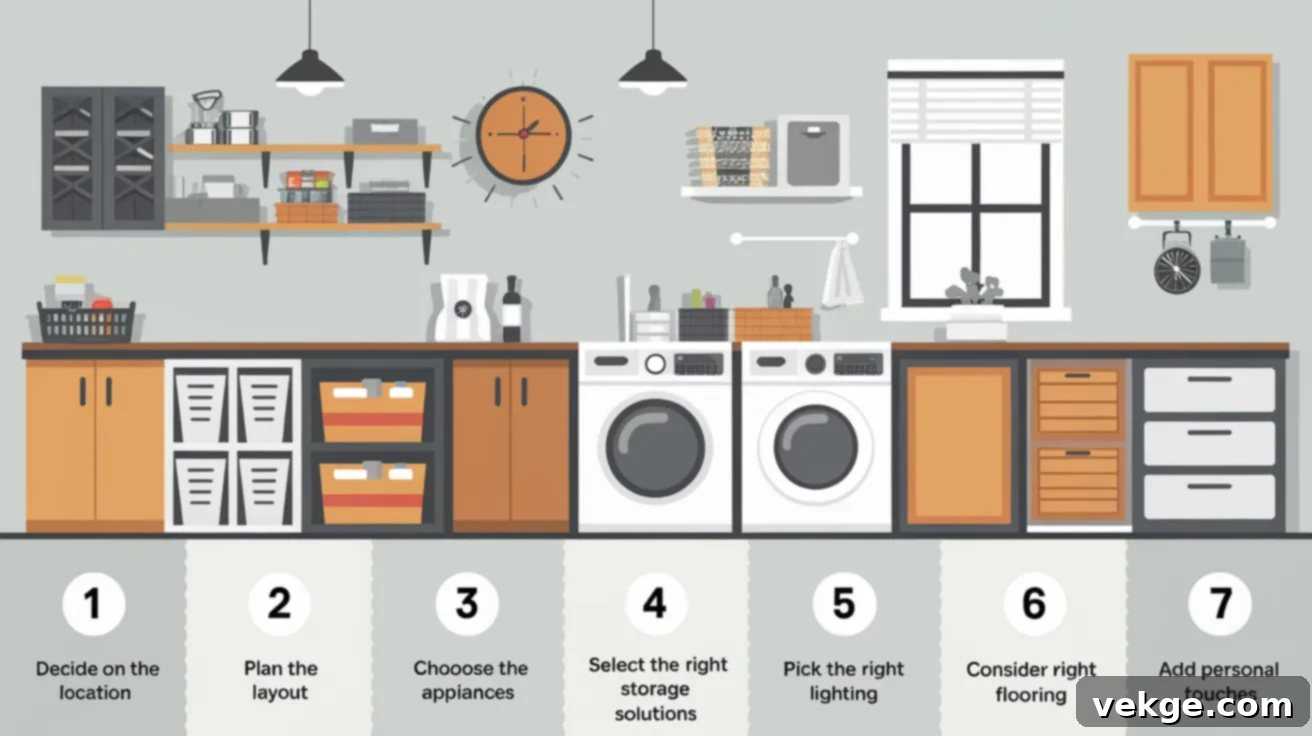
A laundry room is much more than just a place for chores—it can be one of the most practical and helpful spots in your entire home. Thoughtful planning can significantly save you time and make everyday tasks considerably easier. Here’s a clear, step-by-step guide to help you get started on designing a functional laundry room that works efficiently for your household needs, providing an organized and pleasant environment for completing chores.
Step 1: Define Your Goals and Needs
Begin your laundry room design journey by clearly establishing what you want to achieve with the space. Consider which functions are most critical for you: do you need extensive additional storage, a dedicated folding area, ample hanging space for delicate items, or perhaps a small craft station? Create detailed lists of both essential and desired features. Think deeply about your typical laundry routines – how often do you wash, what types of items, and how many people are in your household? This assessment ensures your design truly accommodates your actual usage patterns and priorities.
Step 2: Measure and Assess the Space
Before any purchases or major decisions, meticulously measure the entire room. Document ceiling height, all wall dimensions, and door clearances. Crucially, note the exact positions of existing windows, ventilation vents, water connections, and electrical outlets. These fixed elements will significantly influence your layout options and may necessitate professional modifications, so having accurate measurements from the start is vital for effective planning.
Step 3: Choose the Right Layout
Selecting an optimal layout is key to an efficient laundry room. Consider various configurations that align with your needs:
- Side-by-side appliances: Ideal for larger spaces, allowing for a generous folding counter above.
- Stacked machines: A fantastic space-saving solution for compact areas, freeing up floor space.
- U-shaped or L-shaped configurations: Maximize counter space and workflow efficiency, creating distinct zones for different tasks.
Always think about traffic flow; ensure there is adequate room to comfortably move around, especially when machines are operating, and doors or drawers are open.
Step 4: Plan Effective Storage Solutions
When planning storage, consider every item you’ll need to accommodate, from bulky detergents and fabric softeners to laundry baskets, ironing supplies, and general cleaning products. Incorporate a blend of closed cabinets to conceal less attractive items and open shelving for frequently used products or decorative touches. Pull-out drawers or bins can dramatically improve accessibility to items stored at the back, while vertical organizers can maximize space on cabinet doors or narrow gaps.
Step 5: Consider Lighting and Ventilation
Effective lighting and robust ventilation are non-negotiable elements in laundry room design. Install a combination of ceiling fixtures for ambient light, task lighting (such as under-cabinet lights) for specific work areas, and perhaps even decorative wall sconces to enhance the mood. Position lights strategically above folding counters and utility sinks for optimal visibility. Ensure proper ventilation through adequately sized windows, exhaust vents, or high-capacity fans to prevent moisture accumulation, control humidity, and inhibit mildew growth, protecting both your home and your health.
Step 6: Select Practical Finishes
Choose practical finishes that are not only aesthetically pleasing but also highly resistant to moisture and easy to clean. For flooring, consider durable options like ceramic tile, luxury vinyl plank, or sealed concrete. Select moisture-resistant paint for walls, and opt for water-resistant materials such as quartz, laminate, or solid surface for countertops and cabinets, as these areas are frequently exposed to splashes and humidity. Durability and ease of maintenance should be your top priorities.
Step 7: Add Functional Extras
Finally, enhance functionality with thoughtful extras if your space permits. A drying rod or rack is invaluable for air-drying delicate garments or items that cannot go into a dryer. A pull-out hamper system with multiple compartments simplifies laundry sorting, and a utility sink remains a lifesaver for hand-washing or pretreating heavily soiled items. Consider a compact, fold-away ironing board or a dedicated area for a steamer to boost convenience. If you spend significant time in the laundry room, a small seating area or a comfortable stool can make the process much more pleasant. These carefully considered additions can truly transform an ordinary laundry room into a more efficient, enjoyable, and less burdensome space for household chores.
Layout & Design Tips by Space Size
Designing a laundry room requires careful planning tailored to your specific available space. With the right setup, even the smallest area can be transformed into a highly practical and efficient workspace.
Small-Space Solutions
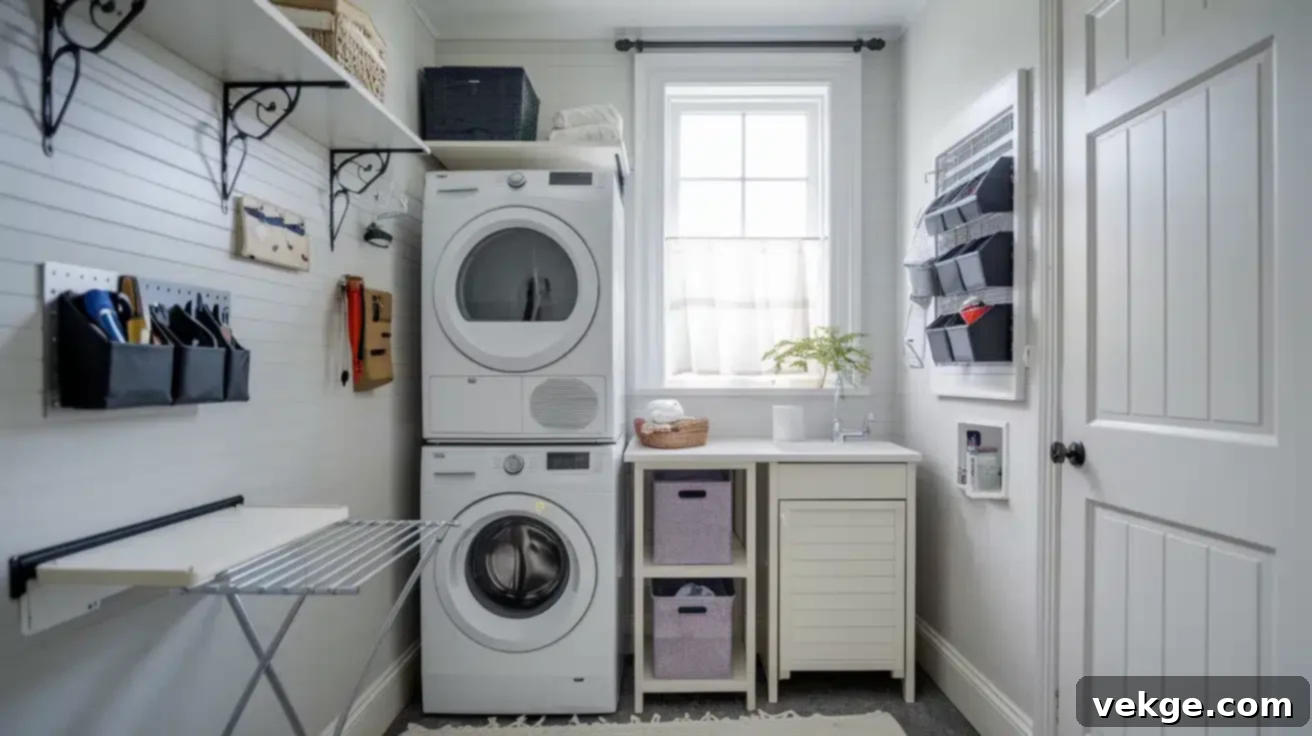
Compact laundry spaces demand exceptionally thoughtful and creative planning to maintain full functionality. In apartments, closets, or narrow rooms, maximizing vertical space is absolutely key. Wall-mounted shelves, versatile fold-away drying racks, and efficient stackable washer-dryer units are essential to utilize height without feeling cramped. Sliding cabinet doors save valuable floor space compared to hinged doors, while magnetic strips are ingenious for keeping small tools, cleaning cloths, or even measuring cups organized and easily accessible. Compact rolling carts offer flexible storage that can be easily tucked away when not in use. Features like fold-down ironing boards, over-the-door organizers, and multi-functional storage benches make it entirely possible to turn even the tiniest corner into a complete and highly efficient laundry zone.
Medium-Sized Laundry Room Layouts
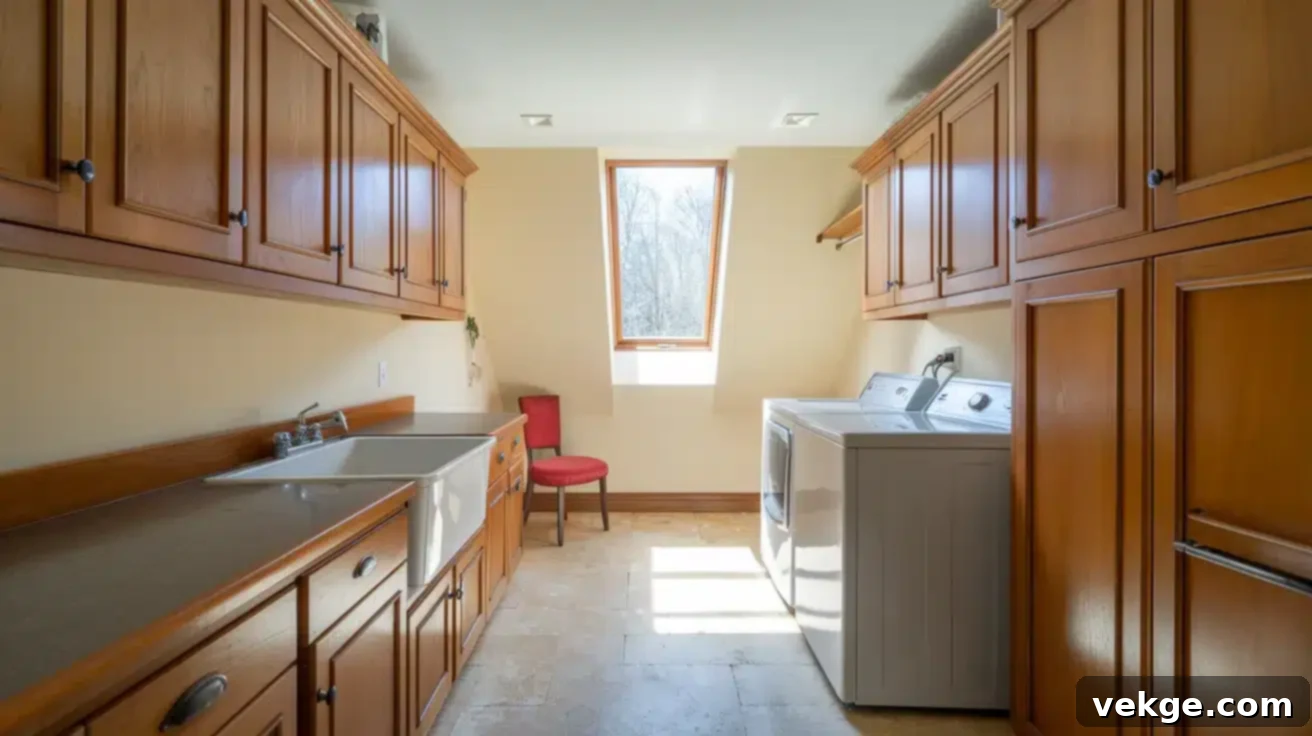
Medium-sized laundry rooms offer considerably greater flexibility in layout and design, allowing you to create an efficient setup that supports your routine and keeps everything impeccably organized. An L-shaped or U-shaped layout works exceptionally well, helping to establish natural, distinct zones for washing, drying, folding, and storage. A sturdy, expansive countertop provides a convenient and ample surface for sorting and folding clothes. Cabinets positioned both above and below the countertop offer invaluable storage for detergents, cleaning supplies, and fresh linens, keeping the space clutter-free.
Including a utility sink adds immense practicality for hand-washing delicate items or pretreating stubborn stains. A hanging rod is also an incredibly helpful addition for air-drying clothes or hanging items fresh out of the dryer to prevent wrinkles. Pull-out hampers make sorting laundry easier and contribute significantly to keeping the entire space neat and tidy. Good lighting is absolutely essential; a mix of ceiling lights for general illumination and task lighting (e.g., under-cabinet lights) will keep the area bright and functional, making everyday chores feel significantly less burdensome.
Large and Luxury Laundry Setups
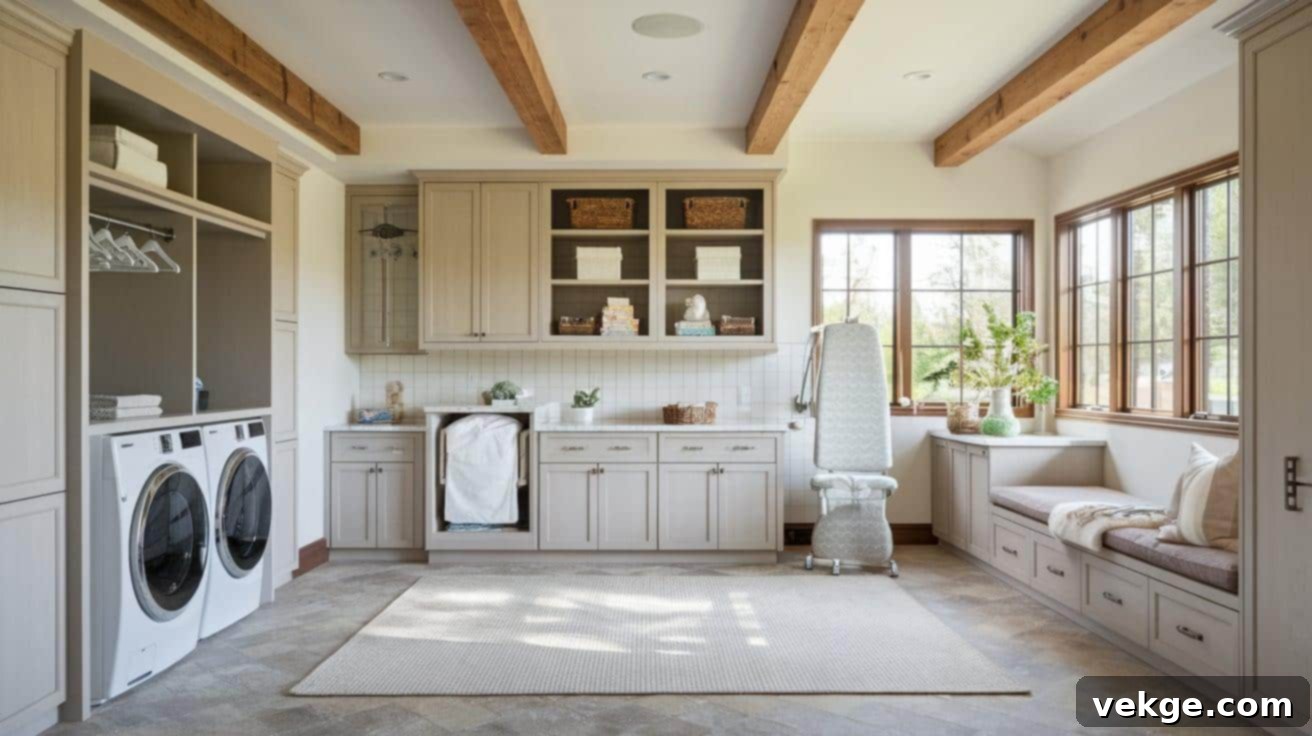
Large laundry rooms present a unique opportunity to transcend basic functionality and craft a truly well-rounded, comfortable, and luxurious space. With ample room to work with, you can design clear, expansive zones for washing, drying, folding, and extensive storage, making your laundry routine effortlessly efficient. You might consider installing multiple high-end appliances, such as a steam washer and dryer set, a dedicated drying cabinet for delicate items, and a built-in ironing station or even a small desk for administrative tasks.
Custom, floor-to-ceiling cabinetry can be designed to house everything from cleaning supplies and seasonal linens to crafting materials and other household essentials, ensuring the space remains immaculately tidy and organized. There’s also considerable room to infuse personal touches: a small desk or reading nook, soft and inviting flooring underfoot, and thoughtful design features can transform the laundry room into a pleasant, highly functional, and luxurious extension of your main living space, making chores feel less like a task and more like a moment of peace.
Universal Design Principles for Every Laundry Room
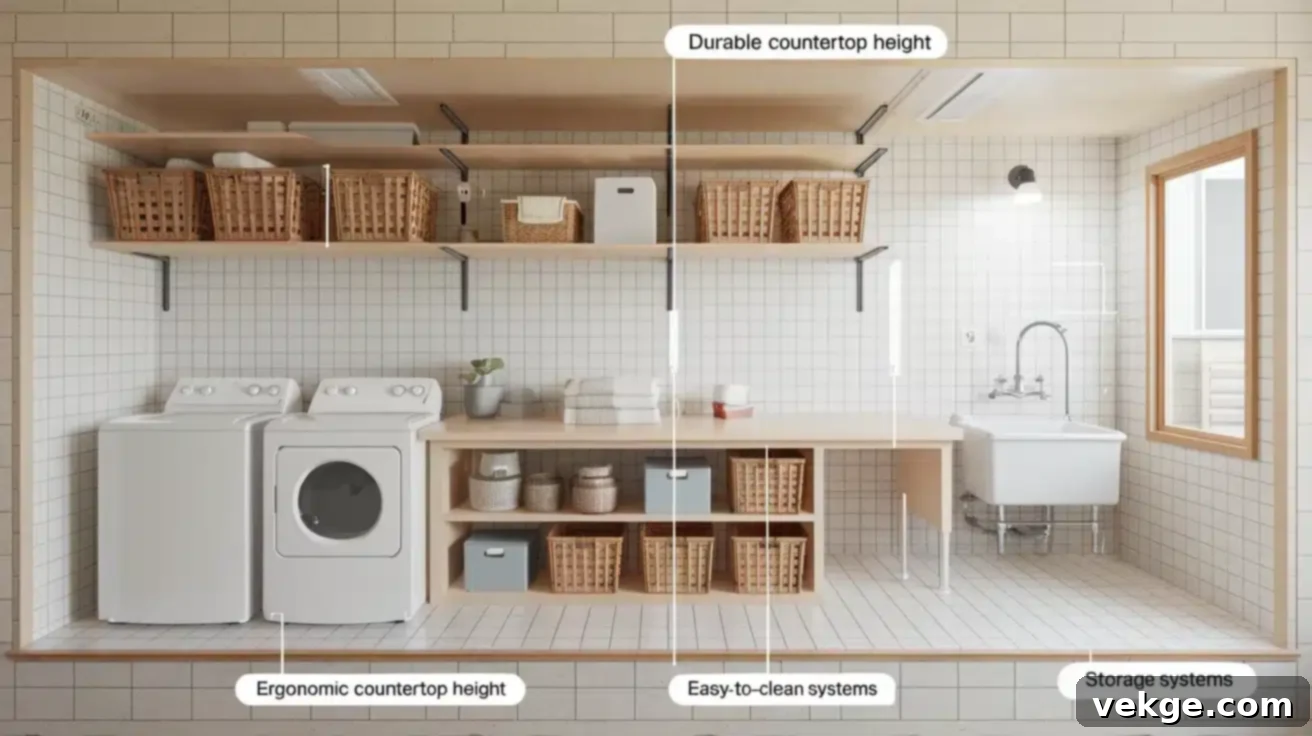
Regardless of its size, successful laundry room design consistently focuses on three crucial elements:
- Efficient workflow: A logical progression from dirty to clean.
- Smart storage solutions: Maximizing space and minimizing clutter.
- Comfortable working height: Ergonomic considerations for all users.
Always choose materials that are highly resistant to moisture, prioritize surfaces that are easy to clean and maintain, and thoughtfully consider ergonomics in every design choice. The overarching goal is to create a space that genuinely simplifies your routine and makes laundry tasks more manageable and less strenuous for everyone in the household.
Laundry and Mudroom Combos: Maximizing Functionality
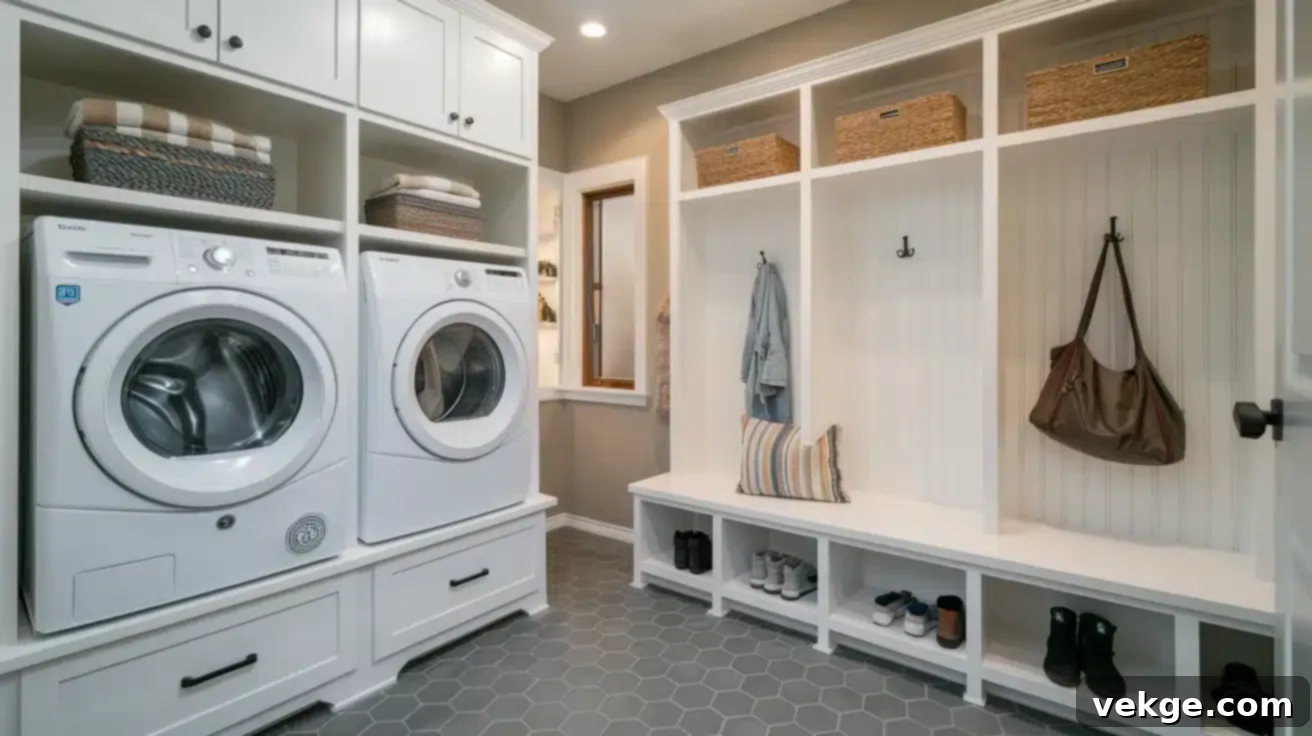
Combining laundry and mudroom functions creates an incredibly efficient, organized, and multi-purpose space that adeptly handles various household tasks in one streamlined area. This integration is perfect for busy families, particularly those with active lifestyles, children, or pets, as it centralizes the management of outdoor gear, dirty clothes, and household clutter.
Design Strategy for Combo Spaces
Successful laundry-mudroom combo spaces are characterized by a seamless blend of practical storage and smooth traffic flow. The key is to clearly divide the area into distinct, functional zones: an entry zone for shedding outer layers, a cleaning station for immediate laundry processing, and a dedicated storage hub for organization. Position washers and dryers strategically near the entry point to immediately capture dirty clothes, muddy shoes, and outdoor gear, preventing mess from spreading into the main living areas. Consider durable, easy-to-clean flooring and wall finishes in this high-traffic area.
Smart Storage Solutions for Combo Rooms
Custom cabinetry and built-ins are absolutely crucial for these integrated spaces. Design these to accommodate:
- Lockers or cubbies: Individual compartments for each family member’s coats, backpacks, and shoes.
- Benches with hidden storage: Provide a convenient spot to sit while removing shoes, with built-in storage underneath.
- Deep shelving: For sports equipment, pet supplies, or cleaning products.
- Hooks at multiple heights: To hang coats, bags, and smaller items.
- Adjustable shelving: To maximize vertical space and adapt to varying storage needs.
Create a logical workflow: dirty items enter the mudroom, are immediately sorted and processed in the laundry area, and then clean items are stored or distributed. This systematic approach ensures maximum organization and efficiency, making daily transitions smoother and keeping your home tidier.
Common Laundry Room Design Mistakes to Avoid
Thoughtful organization can transform any space from cluttered chaos into a functional, efficient environment that simplifies daily living and significantly reduces stress. Being aware of common pitfalls can save you time, money, and frustration during your laundry room design process.
1. Poor Lighting Troubles
A poorly lit laundry room is not just uninviting; dark spaces make organization incredibly challenging, as shadows can hide clutter and make rooms feel significantly smaller and dingier. Insufficient light can also lead to missed stains on clothing. To combat this, ensure a layered lighting scheme:
- Ambient lighting: Overhead fixtures like flush mounts or LED panels for general illumination.
- Task lighting: Install LED strips under cabinets, puck lights above shelves, or adjustable fixtures over your folding counter.
- Accent lighting: If space allows, decorative sconces can add warmth and style.
Consider the color temperature of your lights; cooler white light (4000K-5000K) is excellent for task areas as it closely mimics daylight and reveals true colors, while warmer light (2700K-3000K) can make the space feel cozier.
2. Counter Space Limitations
Cramped or non-existent counter surfaces create instant chaos in a laundry room, making sorting, folding, and treating stains a frustrating experience. Even compact rooms need smart solutions to maximize work surfaces.
- Fold-down tables: Attach to walls and can be put away when not in use.
- Mobile utility carts or islands: Offer built-in storage and can be wheeled to where they are needed.
- Pull-out shelves or cutting boards: Integrated into cabinetry, providing extra temporary workspace.
- Appliance pedestals with drawers: Elevate machines and provide a counter-height surface if topped with a custom board.
Every inch of usable surface can make a big difference in a small laundry room, so think vertically and creatively about expanding your workspace.
3. Moisture and Airflow Issues
Trapped humidity and poor airflow are detrimental to any laundry room, leading to mildew growth, musty odors, and potential damage to walls, cabinets, and even your clothes and supplies. Damp spaces will quickly ruin your storage efforts.
- Ensure proper ventilation: Install a high-capacity exhaust fan, connected to an exterior vent, and use it consistently during and after cycles.
- Open windows: If possible, open a window after washing to air out the room.
- Select moisture-resistant materials: For walls, flooring, countertops, and cabinetry to prevent warping or mold.
- Use dehumidifiers: In particularly humid climates or basements, a small dehumidifier can be highly effective.
- Utilize desiccants: Drop silica gel packets into storage containers with linens or delicate items for long-term protection.
Prioritizing adequate ventilation and moisture control is crucial for maintaining a healthy, functional, and pleasant laundry environment.
Conclusion
Transforming your laundry room from a basic chore zone into a space that feels practical, comfortable, and aesthetically pleasing is entirely achievable. With the right strategic approach, even the most routine household tasks can become significantly less stressful and far more satisfying. Smart design transcends mere appearances; it deeply focuses on how the room functions to support your daily needs and enhance your quality of life.
By thoughtfully combining efficient storage solutions, ample and well-distributed lighting, ergonomic considerations, and simple yet personal touches, you can create a laundry room that seamlessly supports your routine and feels genuinely good to spend time in. A well-planned and meticulously designed laundry room doesn’t just clean clothes; it helps you stay organized, save precious time, and ultimately, enjoy the process a little more, adding tangible value and comfort to your home.
Frequently Asked Questions About Laundry Room Design
How much space do I need for a laundry room?
The space required for a laundry room largely depends on your chosen setup. A compact laundry area, often found in a closet, can fit into as little as 3 to 4 feet of width and depth with stackable machines. A full-size laundry room with side-by-side appliances, a utility sink, and counter space typically requires 6 to 10 feet of width or more, depending on additional features and storage needs. Always measure your appliances and consider workflow before planning.
What are the best materials for laundry room countertops?
For laundry room countertops, durability, moisture resistance, and ease of cleaning are paramount. Popular and highly recommended choices include:
- Quartz: Non-porous, highly resistant to stains and scratches, and available in many colors.
- Laminate: An affordable option with a wide range of styles, though less heat resistant than quartz.
- Butcher Block: Offers a warm, natural look but requires regular sealing to protect against moisture.
- Solid Surface: Durable, non-porous, and seamlessly integrated sinks are possible.
These materials all hold up well against water and heat, making them practical for daily laundry tasks.
Can I combine my laundry room with a mudroom?
Yes, combining your laundry room with a mudroom is an excellent and increasingly popular design choice! This integration can significantly save space and create a highly efficient hub for managing dirty clothes, shoes, outdoor gear, and household clutter all in one concentrated spot. To ensure success, it’s crucial to divide the space into clear, distinct zones for each function (e.g., a “dirty” entry zone and a “clean” laundry zone) and to invest in smart, durable storage solutions for both areas.
